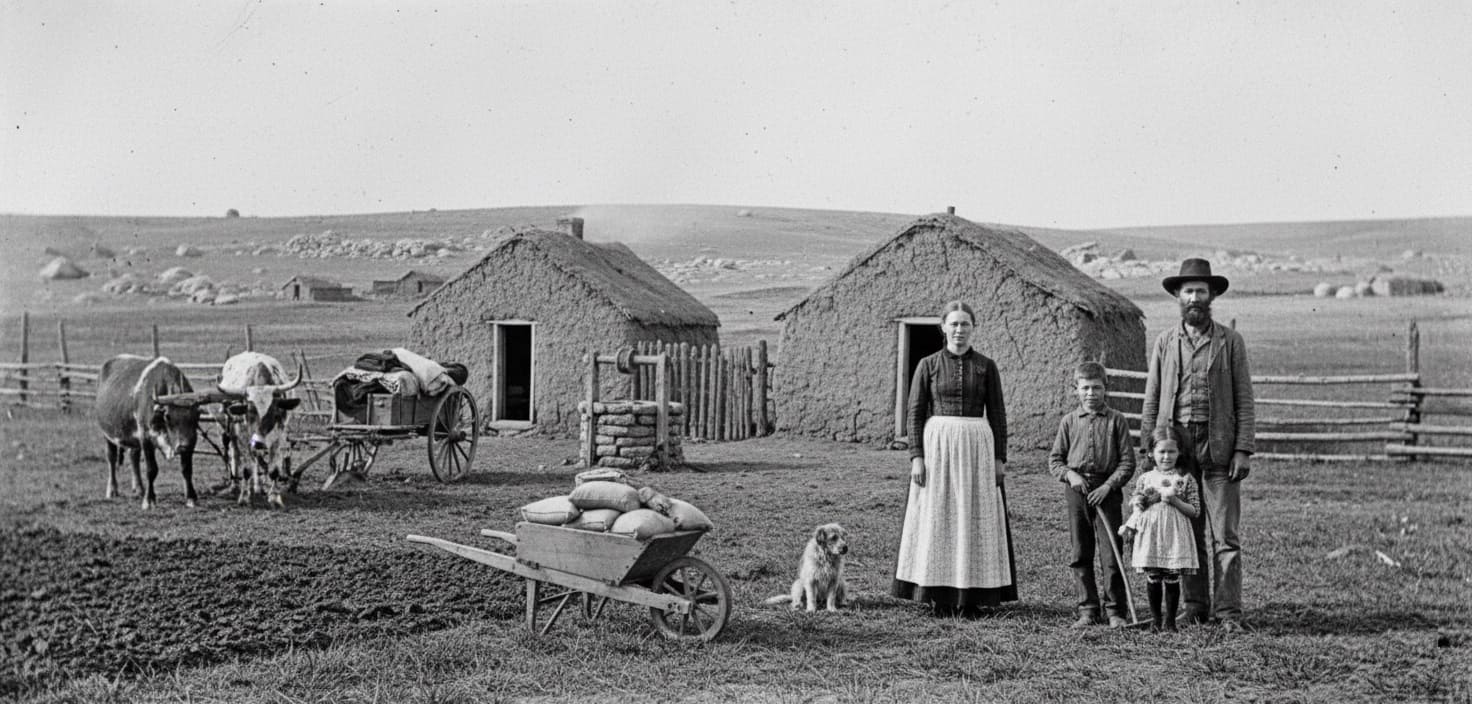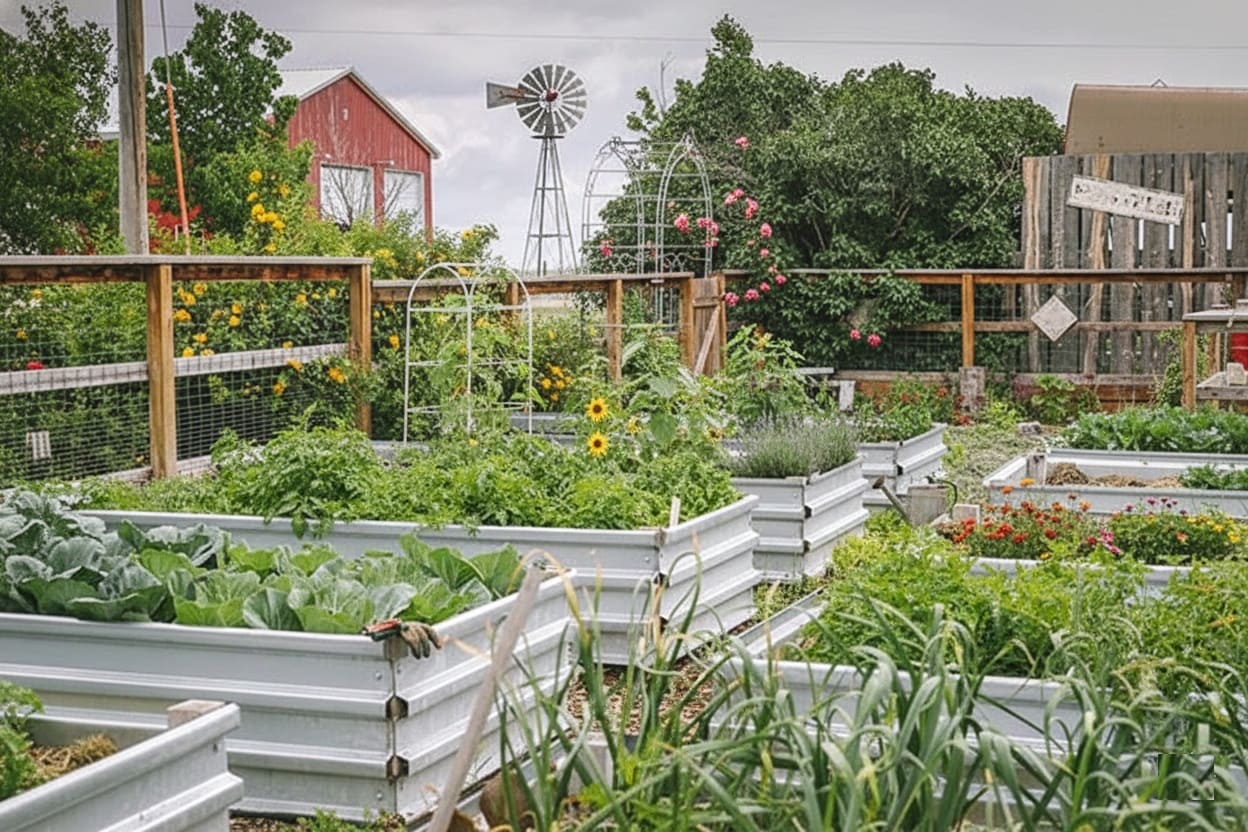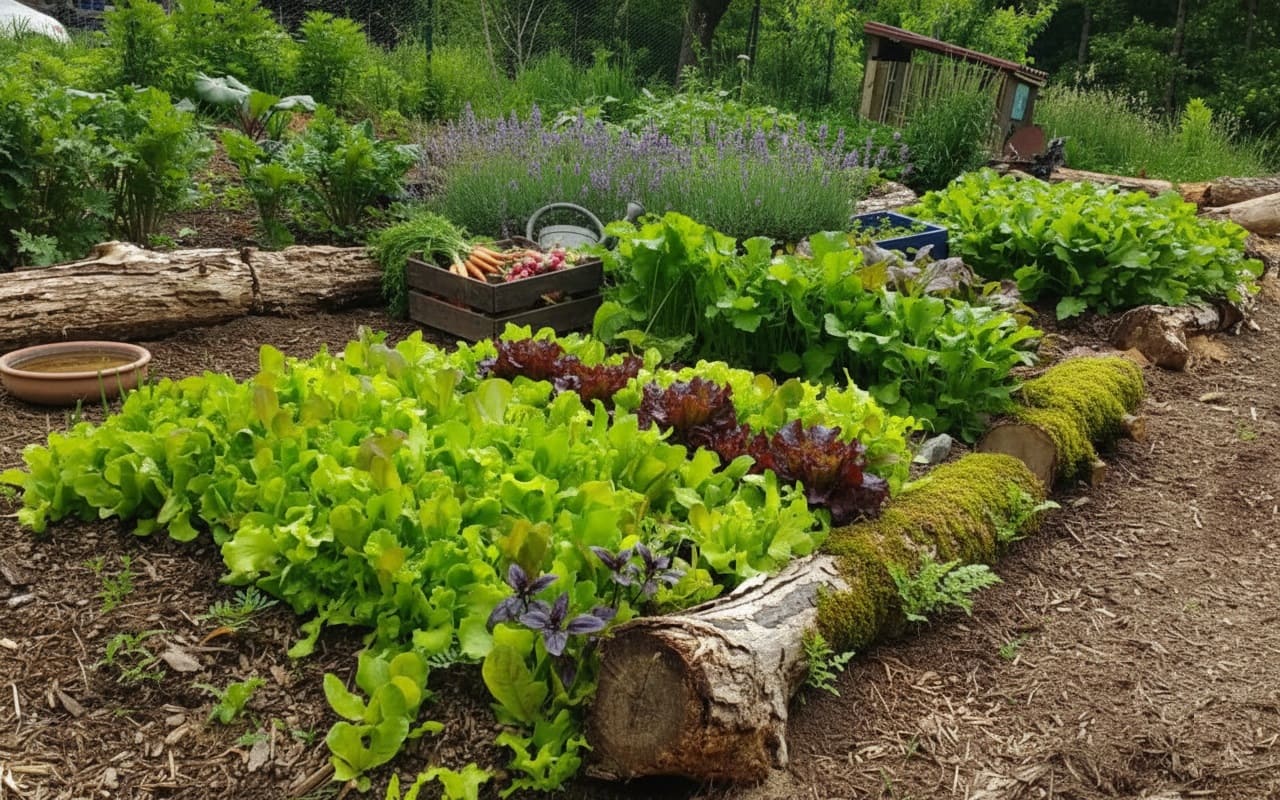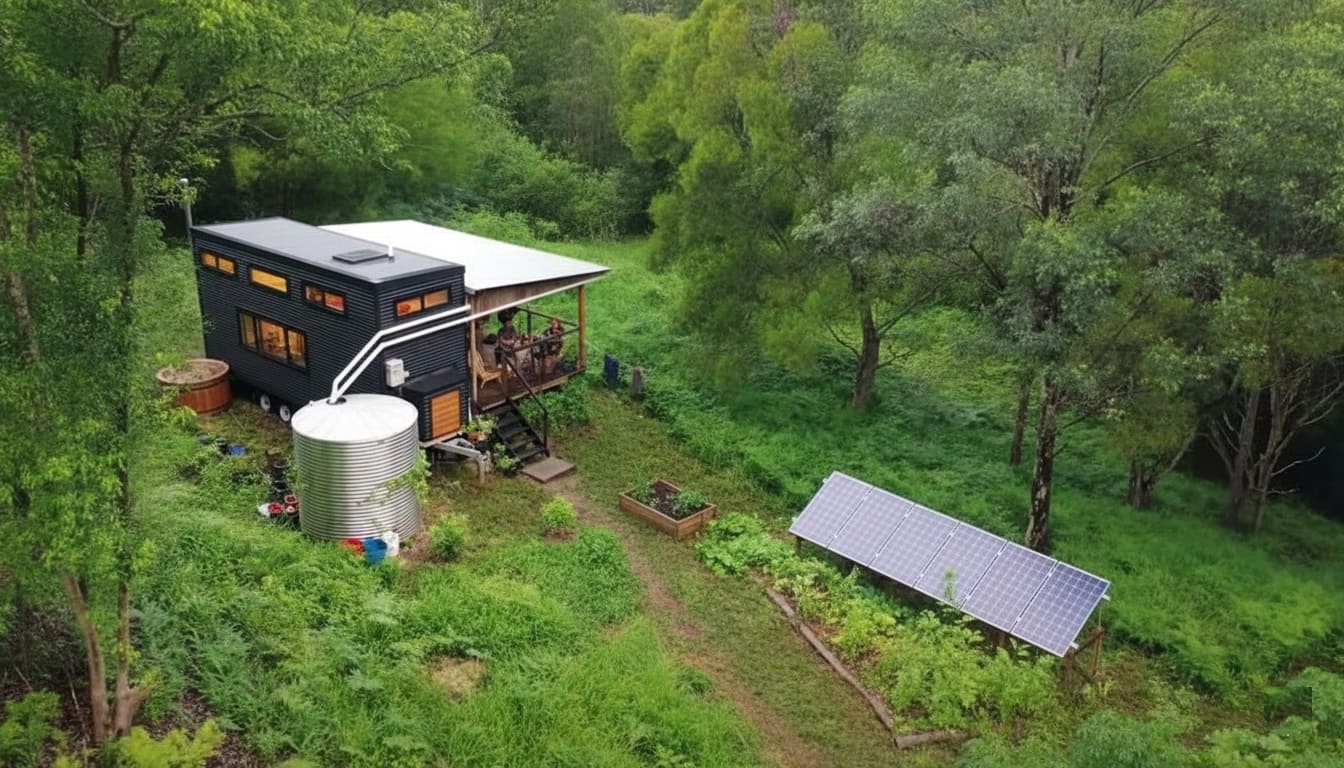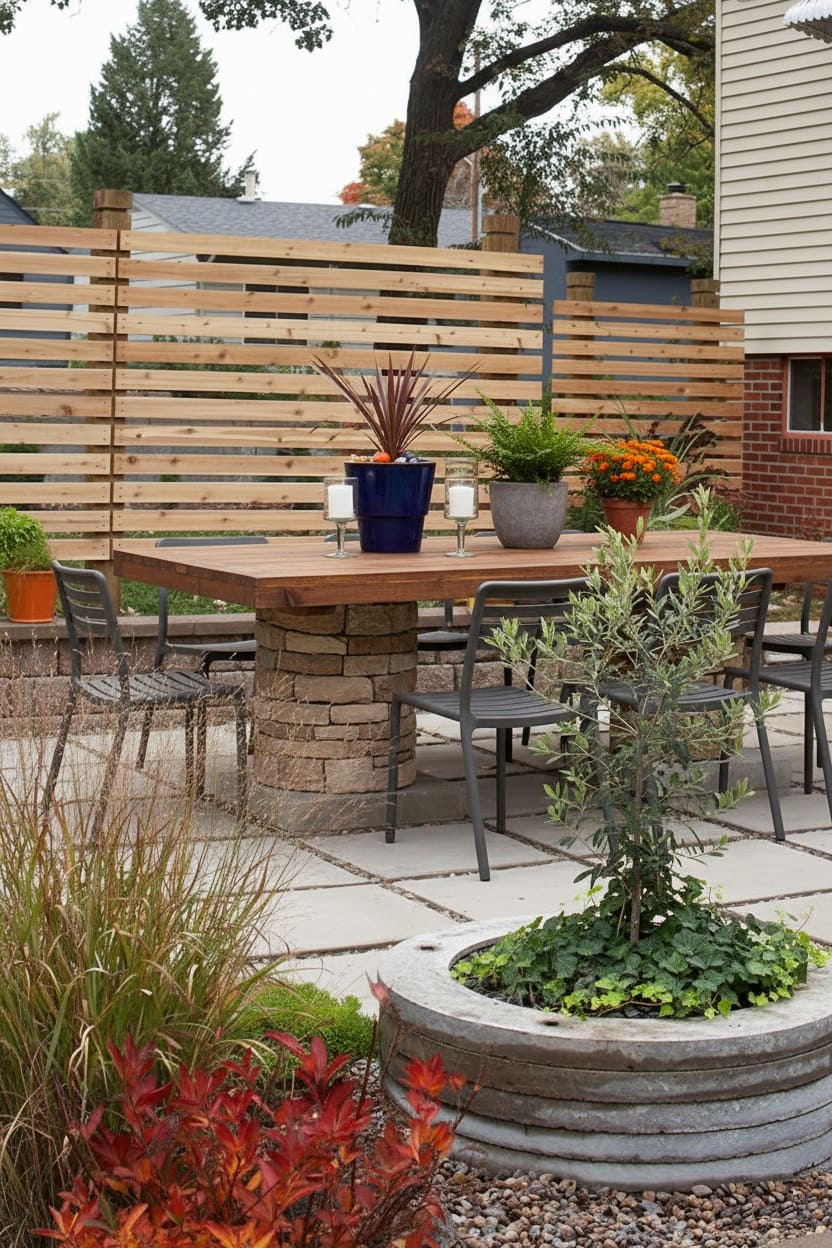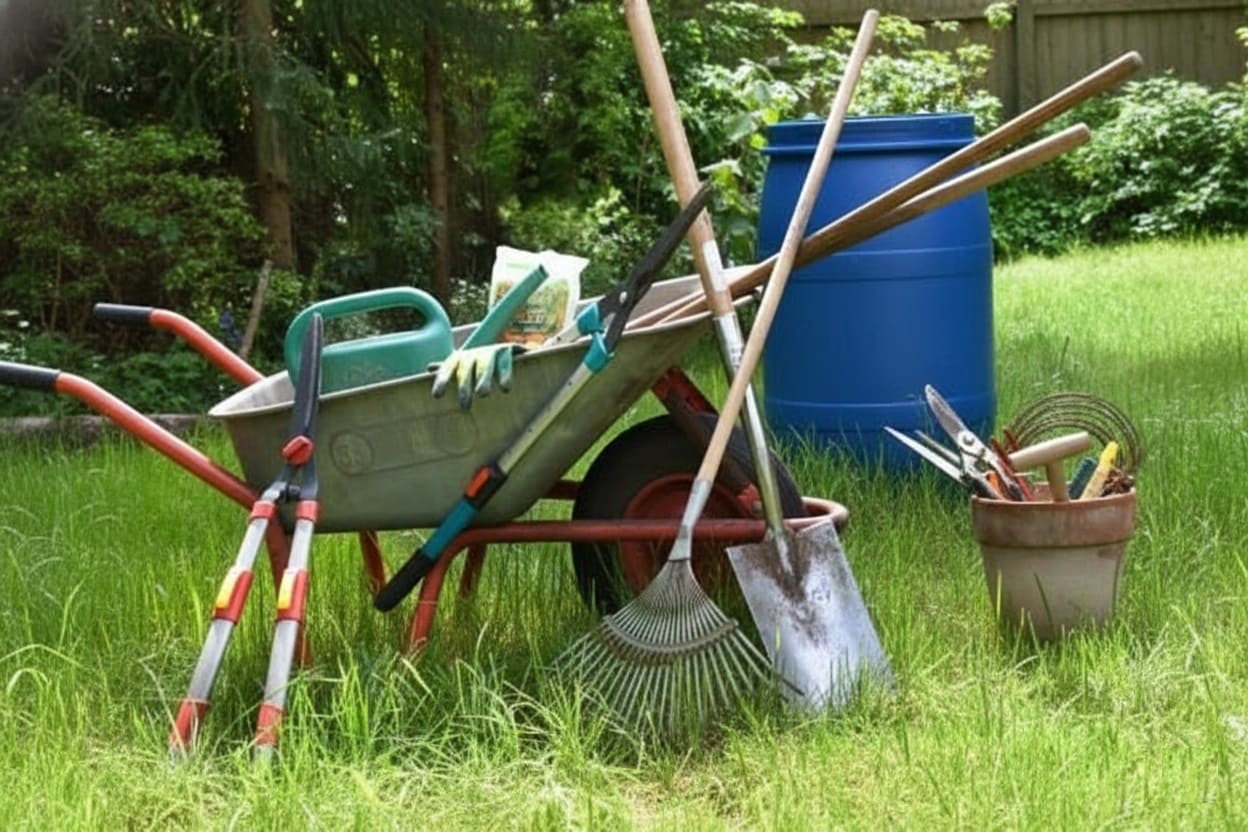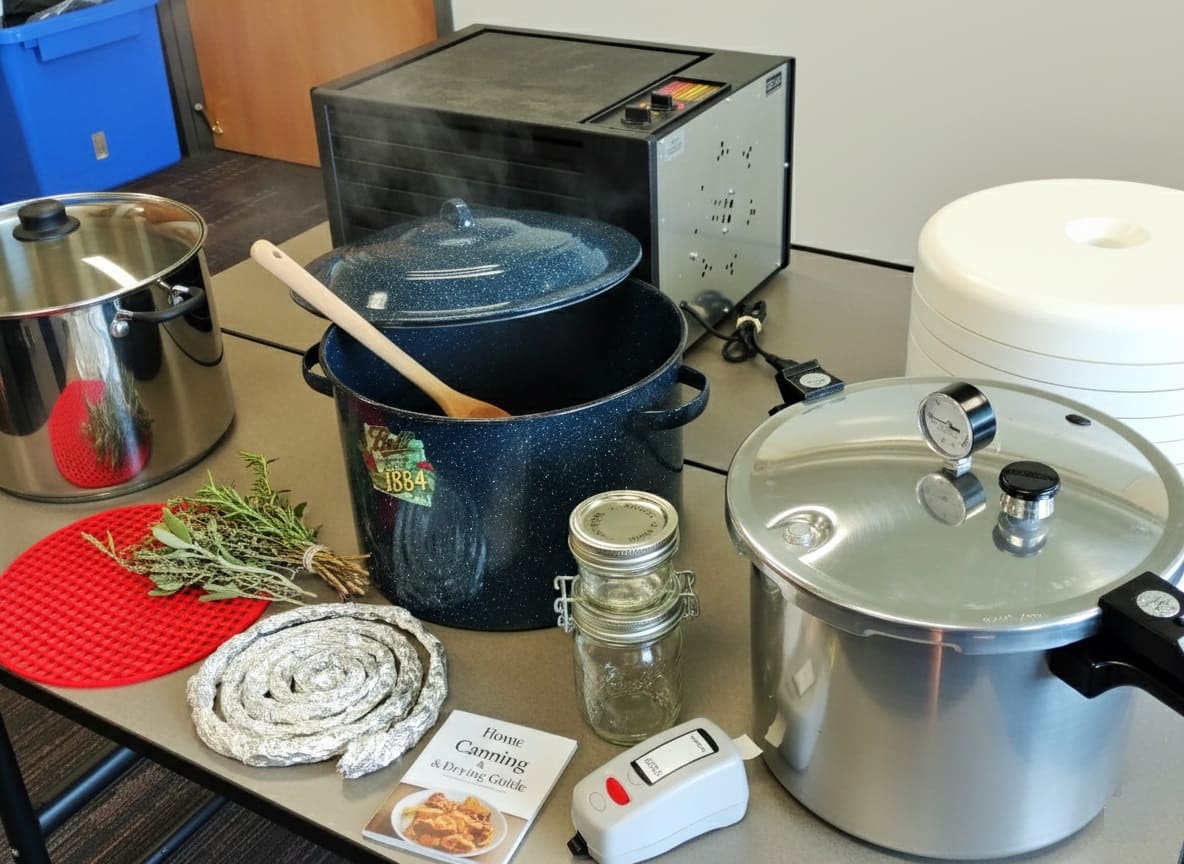Picture this: You’re standing in your kitchen, slicing tomatoes you grew from seed, bread dough rising on the counter beside you, eggs from your backyard chickens waiting to be scrambled.
The afternoon sun streams through your window, and you realize you haven’t stepped foot in a grocery store in two weeks. This isn’t a fantasy from 1862—this is modern homesteading, and it’s more accessible than you might think.
Whether you’re craving a deeper connection to your food, seeking financial independence, or simply tired of the industrial treadmill, homesteading offers a path back to something more authentic.
But here’s what most people get wrong: you don’t need 100 acres and a barn full of livestock to call yourself a homesteader. You just need the willingness to start producing more than you consume, right where you are.
What Is Homesteading, Really?
The Historical Roots
The term traces back to the Homestead Act of 1862, when President Abraham Lincoln signed legislation offering 160 acres of public land to citizens willing to cultivate it for five years.
Between 1862 and 1934, this program transferred over 270 million acres—more than 10% of the United States—to private ownership.
Those original homesteaders faced incredible hardship. They built homes from prairie sod, used buffalo dung for fuel when trees were scarce, and battled drought and insect plagues.
Yet they persevered, driven by the promise of land ownership and independence—luxuries many had never known.
It’s important to acknowledge the dark side: this “public land” wasn’t empty. Native Americans were forcibly removed, a painful legacy that shouldn’t be glossed over when we discuss homesteading’s origins.
The Modern Definition
Modern homesteading has transformed into a lifestyle philosophy centered on self-sufficiency, sustainability, and intentional living.
It’s about providing for your own needs—whether food, energy, clothing, or products—rather than relying solely on industrial systems.
At its core, homesteading means choosing to be a producer rather than just a consumer. It’s asking “What can I make, grow, mend, or create?” instead of defaulting to “What can I buy?”
One person’s homestead might involve growing tomatoes on an apartment balcony and brewing kombucha.
Another’s might include raising cattle on 50 acres. Both are equally valid expressions of homesteading principles. There’s no certification board determining who qualifies—you define it for yourself.
Common Myths Debunked
- Myth: You need extensive land – Urban homesteading thrives in small spaces through container gardens, balcony chickens, and community plots.
- Myth: You must reject all modern conveniences – Most homesteaders blend traditional skills with helpful technology like solar panels and electric tools.
- Myth: Complete self-sufficiency is the goal – Homesteading exists on a spectrum. Any step toward self-reliance counts. Nobody produces 100% of what they need, and aiming for that often leads to burnout.
- Myth: It’s always cheaper – Startup costs can be substantial. Long-term savings materialize, but expect significant initial investment.
Why Homesteading Calls to People Today
The COVID-19 pandemic accelerated interest in homesteading, but deeper cultural currents were already flowing.
When grocery shelves emptied in 2020, people realized how fragile our food system is. Empty shelves sparked something primal—a recognition that depending entirely on complex supply chains creates vulnerability.
But the motivations run deeper than emergency preparedness.
- Our modern food system prioritizes shelf life and profit over nutrition.
- Produce is harvested unripe and shipped thousands of miles.
- Meat comes from crowded operations feeding animals unnatural diets.
- Processed foods dominate supermarket shelves, and chronic disease rates climb steadily.
Homesteaders often report dramatic health improvements after shifting to food they produce. Fresh vegetables picked at peak ripeness contain more vitamins. Eggs from pastured chickens offer better nutrient profiles.
For people managing autoimmune conditions or food sensitivities, controlling what goes into their bodies becomes transformative.
The economic appeal is real despite startup costs.
- After initial investment, growing vegetables slashes grocery bills.
- Preserved abundance feeds families year-round.
- Raising chickens provides eggs at a fraction of store prices.
- DIY skills eliminate contractor expenses.
Some homesteaders build enough financial independence to leave traditional employment, though this requires years of infrastructure development.
Perhaps most compelling is what homesteading offers our mental health. We’re experiencing a crisis of anxiety and depression coinciding with increasingly disconnected, screen-focused, nature-deprived lifestyles.
Homesteading provides antidotes: purposeful physical labor with tangible results, natural rhythms restoring circadian health, outdoor time calming nervous systems, mastery building confidence, and profound connection to land, food, family, and something larger than ourselves.
Industrial agriculture is a leading contributor to climate change, water pollution, and biodiversity loss.
Every homesteader becomes a node in a regenerative network, proving another way is possible through composting, organic growing, pastured animals, and reduced consumption.
Paradoxically, choosing self-sufficiency often strengthens community. Homesteaders trade excess eggs for honey, share equipment, help with projects, and teach each other skills. In an age of profound loneliness, these genuine connections matter immensely.
Finding Your Homesteading Path
Urban Homesteading
City living doesn’t disqualify you—it requires creativity.
Urban homesteaders maximize limited space through container gardens on patios and balconies, vertical growing with trellises and wall planters, community garden plots, indoor cultivation of microgreens and herbs, backyard chickens where ordinances allow, and mastering preservation skills like canning purchased produce.
They often partner with local farmers through CSAs, creating resilient food networks while supporting sustainable agriculture.
Suburban Homesteading
Suburbs offer a sweet spot—more space than urban settings while remaining close to amenities.
Suburban homesteaders enjoy larger gardens with fruit trees and berries, small livestock like chickens and rabbits, beehives for honey and pollination, dedicated preservation areas, and renewable energy systems.
The challenge often involves navigating HOA restrictions and neighbor relationships. Starting small, being considerate, and sharing your bounty wins people over.
Rural and Off-Grid Homesteading
Rural properties provide space for extensive gardens and orchards, larger livestock, firewood management, off-grid energy systems, and multiple outbuildings.
But more land brings more responsibility—maintenance demands multiply, isolation challenges arise, and distance from services requires adjustment.
Off-grid living represents the extreme end, involving complete independence from utilities through solar/wind power, well water or rainwater collection, septic or composting toilets, and wood heating.
It requires substantial investment, maintenance skills, and acceptance of reduced convenience.
The Hybrid Approach
Most homesteaders aren’t doing it full-time. Many maintain jobs covering expenses like property taxes and healthcare. This hybrid approach is often more sustainable than going “all in” immediately.
Part-timers might work remotely while tending homesteads, hold seasonal jobs with homesteading focus during off-seasons, or gradually build infrastructure while maintaining careers.
The Homesteading Mindset: Where Success Begins
Embrace the Producer Mentality
We live in a consumer culture where the default response to any need is “buy it.” Homesteading flips this script. Train yourself to pause before purchasing and ask:
- Can I make this?
- Can I repair rather than replace?
- Can I grow this ingredient?
- Can I learn this skill rather than hiring it out?
This doesn’t mean rejecting all purchases—that’s unrealistic. It means consciously choosing when to DIY versus when to buy, based on your skills, time, and values.
Start practicing now: Next time something breaks, watch a repair video before discarding it. When a recipe calls for expensive premade stock, make bone broth from kitchen scraps. These small acts build producer confidence.
Set Honest, Achievable Goals
Pinterest-perfect homesteads don’t show the crop failures, predator attacks, and exhausting workload happening behind the scenes. Prevent burnout by assessing your actual resources:
- Time – How many hours weekly can you realistically dedicate? Be brutally honest. Homesteading demands more time than you expect.
- Money – What’s your true budget for startup and ongoing costs? Start lean if funds are limited.
- Physical capacity – What can you physically handle? Choose projects matching your actual (not aspirational) ability.
- Support system – Who helps when you’re overwhelmed, sick, or traveling? Homesteading is easier with community.
Identify your specific “why.” Not a generic reason, but your personal motivation:
- “I want to know exactly what’s in my family’s food”
- “I need more meaningful physical work”
- “I’m seeking financial independence from my current career”
Your “why” sustains you through challenges and guides decisions aligned with your values rather than someone else’s dream.
Master one skill at a time. Don’t simultaneously start a garden, get chickens, learn canning, and make soap. That’s a recipe for quitting.
Instead: Year 1—small garden, cooking from scratch. Year 2—food preservation, expand garden. Year 3—chickens, cheesemaking. Year 4—beekeeping, fruit trees. Slow and steady wins.
The One-Year Observation Rule
When you acquire new property, resist immediately tearing into major projects. Spend one full year observing where water pools after rain, which areas get full sun across seasons, where snow accumulates, what wild plants grow naturally, and how wind patterns flow.
Previous owners likely had good reasons for their decisions. Wait until you understand your land before making permanent changes. This patience prevents countless headaches and wasted resources.
Legal and Regulatory Essentials
This is where dream meets reality, and ignoring it causes serious problems. Before buying animals or building structures, understand what’s actually legal in your location.
Zoning Laws and Restrictions
Every municipality has different regulations. Research thoroughly before assuming you can pursue your homesteading plans:
- Animal restrictions
Many areas limit the type and number of animals you can keep. Some ban roosters but allow hens. Others restrict livestock entirely.
Urban areas increasingly allow backyard chickens, but requirements vary—minimum lot sizes, maximum flock sizes, coop setback distances from property lines, and permit requirements.
- Building codes
Chicken coops, sheds, greenhouses, and other structures often require permits. Building without them can result in demolition orders and fines. Some areas have minimum size requirements or maximum building footprints.
- HOA regulations
If you live in a neighborhood with a homeowners association, their rules often exceed municipal codes. Review covenants carefully before purchasing property or starting projects.
- Water rights
In western states particularly, water usage is heavily regulated. You may not have automatic rights to rainwater collection or well water, even on your own property.
- Cottage food laws
If you plan to sell preserved foods, each state has different requirements for licensing, inspections, and approved products. Some states allow home kitchen sales with minimal licensing; others require commercial kitchen facilities.
Where to find information:
- County or city zoning office
- Local extension office
- County clerk’s office for deed restrictions
- State agriculture department for food sales
- Local HOA management if applicable
Call these offices directly rather than relying on websites, which often contain outdated information. Ask specific questions about your planned activities. Get answers in writing when possible.
Protecting Yourself
- Liability insurance – If you have visitors, sell products, or host events, standard homeowner’s insurance may not cover incidents. Consider farm liability insurance or an umbrella policy.
- Proper licensing – Operating without required permits exposes you to fines and legal action. It also jeopardizes your ability to sell products legally.
- Food safety certification – Many states require food handler certification before selling preserved or prepared foods, even at farmers markets.
Don’t let this section discourage you. Most homesteading activities are perfectly legal—you just need to understand the rules in your specific location. Many people have successfully navigated these requirements, and local extension offices often provide free guidance.
Water: Your Homestead’s Foundation
Nothing happens without water. Before fantasizing about abundant gardens and thriving livestock, you need a reliable water source. This is non-negotiable and deserves serious consideration.
Assessing Your Water Supply
- Municipal water
If you’re on city water, you have a reliable supply, but usage costs money. Calculate costs for garden irrigation and animal consumption. In dry climates or during summer, water bills can become substantial.
- Well water
Wells provide independence but require maintenance. Know the well’s depth, recovery rate (gallons per minute), and water quality.
Old wells may have inadequate flow for homestead demands. Drilling new wells costs $15-$30 per foot typically, potentially totaling $15,000-$30,000 depending on depth.
- Surface water
Ponds, streams, or springs can supplement other sources but usually aren’t suitable as primary drinking water without treatment. Surface water works well for livestock and irrigation if available year-round.
- Rainwater collection
Harvesting rainwater from roofs into storage tanks provides free irrigation water. Some systems include filtration for household use. Check local laws—surprisingly, rainwater collection is restricted in some areas.
👉 Here’s How to Use Goldfish for Mosquito Control in Rain Barrels
Water Storage and Management
Even with good supply, storage provides resilience during outages or dry periods. Storage tanks, cisterns, or ponds buffer against shortages. Calculate your actual needs: a family of four uses roughly 300 gallons daily for household purposes.
Gardens require approximately one inch of water weekly, equating to about 600 gallons per 1,000 square feet. One cow drinks 30-50 gallons daily; chickens need about a quarter gallon each.
Consider water efficiency from the start.
- Drip irrigation delivers water directly to plant roots with minimal waste.
- Mulching reduces evaporation and water needs.
- Selecting drought-tolerant plant varieties decreases irrigation demands.
- Proper animal waterer design prevents waste and contamination.
Warning signs of water problems:
- Well pump runs constantly or struggles to keep up
- Water pressure drops significantly
- Cloudy or discolored water
- Bad taste or odor
- High mineral content causing scale buildup
Address water issues immediately. Livestock and gardens can’t wait days for repairs. Have a backup plan—stored water, neighbor access, or hauling capacity.
👉 Learn about Farm Water Planning for Livestock & Land Management
Building Healthy Soil: The Real Foundation
Water may be essential, but soil is where the magic happens. You’re not just growing plants—you’re cultivating an entire ecosystem in your soil. Healthy soil means healthy plants, better yields, fewer pests, and more nutritious food.
Understanding Your Starting Point
Before planting anything, understand what you’re working with. Simple home soil tests reveal pH levels and major nutrient content (nitrogen, phosphorus, potassium).
County extension offices often provide testing services for minimal fees. Professional tests cost more but provide comprehensive analysis including micronutrients and organic matter content.
Different plants prefer different pH levels. Most vegetables thrive in slightly acidic to neutral soil (6.0-7.0 pH). Blueberries want acidic soil (4.5-5.5). Some herbs tolerate alkaline conditions. Adjusting pH takes time—lime raises acidity slowly, sulfur lowers it gradually.
The Soil Building Process
Forget quick fixes. Building genuinely healthy soil takes years, but every season shows improvement. Start with these proven methods:
- Compost addition
This is your most powerful tool. Finished compost adds organic matter, beneficial microorganisms, and slow-release nutrients. Apply 2-4 inches annually, working it into the top several inches of soil. Your garden will reward this investment with vigor you can see.
- Cover cropping
In fall after harvest, plant cover crops like clover, vetch, or winter rye. These plants protect soil from erosion, add organic matter when tilled under in spring, fix nitrogen (legumes), break up compaction with deep roots, and suppress weeds.
It’s free fertilizer that improves soil structure.
- Mulching
Apply 2-4 inches of organic mulch (wood chips, straw, leaves) around plants. Mulch conserves moisture dramatically, suppresses weeds, moderates soil temperature, and decomposes into valuable organic matter. Refresh as needed throughout the season.
- Minimal tillage
Excessive tilling destroys soil structure and kills beneficial organisms. Till only when establishing new beds or incorporating amendments. Otherwise, disturb soil minimally.
- Diversity
Growing different plants in rotation prevents nutrient depletion and disease buildup. Don’t plant tomatoes in the same spot year after year. Rotate plant families through your beds on a 3-4 year cycle.
Healthy soil feels loose and crumbly, is dark with visible organic matter, drains well without staying soggy, contains earthworms and other soil life, and grows vigorous plants with deep green leaves. This doesn’t happen overnight. Be patient. Each season’s improvements compound.
Essential Homesteading Skills and Activities
Growing Food
Gardening is the gateway to homesteading.
There’s magic in planting a seed and harvesting food weeks later. Begin with naturally easy vegetables: lettuce, radishes, zucchini, green beans, tomatoes, and herbs. These forgive beginner mistakes and produce reliably.
Size your garden appropriately. Even a 4×8 raised bed produces impressive yields when well-managed. Better to succeed with a small space than fail with an overwhelming plot.
Companion planting—growing compatible plants together—improves growth and deters pests naturally. Plant basil near tomatoes, marigolds near everything, and carrots near onions.
Extend your season beyond traditional summer growing. Row covers protect from late spring and early fall frosts. Cold frames create microclimates for cool-season crops.
Succession planting—sowing small amounts every two weeks—provides continuous harvests rather than feast-or-famine cycles.
Raising animals adds protein, eggs, dairy, and valuable manure.
- Chickens
Excellent beginner livestock. Three to six hens provide eggs for a family. They’re relatively low-maintenance, eat kitchen scraps and bugs, and produce garden-gold manure.
Expect $300-500 startup costs for coop and supplies, plus $15-20 monthly for feed. Chickens live 5-8 years but production drops after year two or three.
- Ducks
Hardy, excellent foragers, and messy (they love water). Rich eggs are prized for baking. More cold-tolerant than chickens but need water access for swimming.
- Rabbits
Space-efficient meat source with quiet, gentle temperaments. Manure can go directly on gardens without composting. One breeding trio can produce 200+ pounds of meat annually on a tiny footprint.
- Goats
Provide milk, meat, and brush clearing. They’re escape artists requiring secure fencing, need companionship (never keep just one), and demand regular hoof care. A dairy goat produces 6-8 pounds of milk daily during peak lactation.
Important reality:
Animals require daily care, every single day, including holidays and when you’re sick. They get injured, escape, and die unexpectedly. Veterinary care is expensive.
Don’t romanticize animal husbandry. If you’re prepared for responsibility, it’s rewarding. If not, it becomes a nightmare.
Food Preservation: Making Abundance Last
Growing food is half the battle. Preservation allows year-round eating:
- Water bath canning
For high-acid foods (jams, pickles, tomatoes). Sealed jars are processed in boiling water. This beginner-friendly method requires minimal equipment—a large pot, jars, lids, and basic tools. Start with a simple jam recipe to build confidence.
- Critical safety note
Only high-acid foods (pH below 4.6) are safe for water bath canning. Low-acid foods (vegetables, meats, beans) require pressure canning to prevent botulism, a deadly toxin that can form in improperly canned foods.
- Pressure canning
Essential for low-acid foods. Pressure canners reach temperatures above boiling, destroying botulism spores. This requires careful attention to processing times, pressure levels, and safety procedures.
Don’t cut corners. Follow tested recipes from reliable sources like the National Center for Home Food Preservation or Ball Blue Book. Mistakes can literally kill people.
- Freezing
The simplest method. Blanch vegetables (brief boiling followed by ice bath) before freezing to preserve color, texture, and nutrients.
Portion meat in meal-sized packages. Freeze berries on trays before bagging to prevent clumping. Requires electricity and freezer space. Consider what happens during extended power outages.
- Dehydrating
Removes moisture for long-term storage. Electric dehydrators work reliably. Herbs, tomatoes, apples and fruits dehydrate beautifully. Store in airtight containers in cool, dark locations. Properly dried foods last years.

- Fermenting
Beneficial bacteria preserve and enhance food while boosting nutrition. Sauerkraut, pickles, kimchi, sourdough, kombucha, kefir—fermentation is experiencing a deserved renaissance.
This method is actually quite simple and safe when basic guidelines are followed. The beneficial bacteria create acidic environments that prevent harmful organisms.
- Root cellaring
Cool, humid storage for winter crops like potatoes, carrots, apples, squash, and onions.
Doesn’t require electricity but needs proper conditions—temperatures around 32-40°F and high humidity for most crops. Basements, buried containers, or dedicated root cellars work if conditions are right.
Cooking from Scratch
Homesteading and convenience foods don’t mesh well. Learning to cook from whole ingredients becomes essential.
This doesn’t mean never buying prepared food, but shifting the balance toward homemade improves nutrition, reduces costs, and gives you control over ingredients.
Bake your own bread, especially sourdough. Make stocks and broths from bones and scraps. Cook beans and grains from dry rather than canned.
If you have milk access, prepare butter, yogurt, and cheese. Mix your own spice blends and seasonings. Create condiments and sauces.
Batch cooking and thoughtful meal planning prevent scratch cooking from consuming your entire life. Cook once, eat multiple times. Sunday meal prep carries you through busy weekdays.
DIY and Making Things
The homesteading spirit extends beyond food:
- Natural cleaning products – Vinegar, baking soda, castile soap, and essential oils replace toxic commercial cleaners effectively and cheaply. These ingredients handle virtually all household cleaning needs.
- Body care items – Salves, balms, soaps, and lotions from simple ingredients. Once you understand basic formulations, customization is endless.
- Herbal medicine – Garden and foraged plants become tinctures, teas, and remedies. This requires serious study—don’t play doctor with serious conditions—but herbs effectively address minor ailments like cuts, bruises, colds, and digestive upset.
- Textiles and clothing – Sewing, knitting, mending, and repurposing fabric. Even basic skills like hemming pants or patching holes save significant money while reducing waste.
- Furniture and tools – Basic carpentry and metalworking create needed items. Repurposing materials reduces costs further.
You won’t master everything. Pick skills aligned with your interests. Trade with neighbors for complementary abilities—your home-baked bread for their carpentry skills.
Realistic Costs: What to Actually Expect
Let’s talk real numbers because “homesteading will save you money” oversimplifies a complex reality.
Startup Costs
- Urban/apartment homesteading
$200-800 for containers, soil, seeds, basic preservation equipment, and initial supplies.
- Suburban homesteading with chickens and garden
$2,000-5,000 including coop construction ($300-1,500), garden beds and soil ($400-1,000), fencing ($200-600), tools ($300-500), preservation equipment ($400-800), chickens and initial feed ($200-400), and various supplies.
- Small rural homestead (under 10 acres)
$50,000-150,000+ including land purchase (varies enormously by location), well drilling if needed ($15,000-30,000), septic system if needed ($8,000-15,000), outbuildings ($3,000-20,000), fencing ($2,000-10,000), garden infrastructure ($1,000-3,000), animal housing ($2,000-8,000), tools and equipment ($3,000-10,000), and initial livestock and supplies ($2,000-8,000).
- Off-grid rural homestead
Add $20,000-60,000+ for solar power system with battery backup ($15,000-40,000), alternative water systems ($3,000-15,000), backup generator ($2,000-6,000), and wood heating system ($3,000-8,000).
Ongoing Annual Costs
Even established homesteads have recurring expenses:
- Small suburban homestead
$1,500-3,500 annually for chicken feed ($300-600), garden inputs like seeds and amendments ($200-500), animal care and occasional vet visits ($200-600), equipment replacement and repairs ($200-400), preservation supplies like jars and lids ($150-300), property taxes (varies), utilities ($800-1,500), and insurance ($200-400).
- Rural homestead
$5,000-15,000+ annually for animal feed and care ($1,500-5,000), equipment fuel and maintenance ($1,000-3,000), property taxes (varies significantly), insurance ($500-2,000), utilities if on-grid ($600-2,400), vehicle expenses for rural living ($1,500-3,000), and emergency repairs ($500-2,000).
These numbers explain why most homesteaders maintain outside income. Total self-sufficiency is expensive to establish and maintain.
Where Savings Actually Occur
After your infrastructure is in place (typically 3-5 years), meaningful savings emerge:
- Groceries drop $3,000-8,000+ annually for families producing significant food
- Preservation replaces expensive organic products year-round
- DIY skills eliminate contractor costs ($1,000-5,000 annually)
- Reduced consumption lowers overall spending
- No utility bills if off-grid (after recouping installation costs)
- Potential income from surplus products
The payoff is real but delayed. Budget for 5-7 years before breaking even on major homestead investments.
Essential Tools and Equipment
You don’t need everything day one, but certain tools make homesteading possible rather than miserable.
Garden Tools
Immediate needs:
- Quality spade and digging fork ($40-80 each)
- Garden rake and hoe ($25-50 each)
- Hand trowel and pruners ($15-30 each)
- Garden hose and watering wand ($50-100)
- Wheelbarrow ($80-200)
Within first year:
- Broadfork for deep soil aeration ($120-180)
- High-quality loppers ($40-80)
- Soil knife ($25-40)
- Garden cart ($100-300)
Don’t cheap out on: Pruners and spades. Quality versions last decades; cheap ones break within a season.
👉 Unveiling The Must-Have Gardening Tools: Essential Picks for Every Gardener
Food Preservation Equipment
Water bath canning:
- Large pot with rack or actual water bath canner ($30-60)
- Canning jars in various sizes ($8-12 per dozen)
- New lids each year ($3-4 per dozen)
- Jar lifter, funnel, and bubble remover ($15-25)
Pressure canning:
- Pressure canner, not pressure cooker ($120-300 depending on size)
- Same jar supplies as above
Freezing:
- Chest freezer ($200-600 depending on size)
- Vacuum sealer ($40-150)
- Vacuum bags ($20-40 for 100)
- Freezer-safe containers
Dehydrating:
- Electric dehydrator ($60-300 depending on capacity)
- Storage containers or vacuum seal bags
Animal Care Basics
Chickens:
- Secure coop and run ($300-1,500 DIY or purchased)
- Feeders and waterers ($40-80)
- Heat lamp for chicks if starting from babies ($25-40)
- Bedding ($15-30 monthly)
Larger livestock:
- Secure fencing appropriate to species ($3-15 per linear foot)
- Shelter ($500-5,000 depending on size and type)
- Water systems ($100-500)
- Feed storage ($50-300)
- Basic medical supplies ($50-150)
Power Tools Worth Having
- Cordless drill ($80-150)
- Circular saw ($80-150)
- Chainsaw if you have trees ($180-400)
- String trimmer/weed eater ($120-250)
Buy used when possible, especially for items used infrequently. Check Facebook Marketplace, Craigslist, and estate sales for deals.
Your First Year Timeline
Understanding seasonality prevents you from attempting everything simultaneously while missing critical windows. This timeline assumes Northern Hemisphere temperate climate—adjust for your location.
Late Winter (January-February)
- Order seed catalogs and plan garden
- Start cold-hardy seeds indoors (onions, leeks)
- Prune fruit trees while dormant
- Build or repair garden beds and infrastructure
- Attend homesteading workshops and classes
Early Spring (March-April)
- Start more seeds indoors (tomatoes, peppers, herbs)
- Prepare garden beds—add compost, test soil
- Plant cool-season crops directly (lettuce, peas, radishes, carrots)
- Set up rainwater collection
- Order chicks if getting spring chickens
- Begin making maple syrup if you have sugar maples
Late Spring (May-June)
- Transplant warm-season seedlings after last frost
- Direct sow warm-season crops (beans, squash, cucumbers)
- Mulch heavily around plants
- Set up irrigation systems
- Keep weeding—critical now to prevent problems later
- Collect spring nettle and other wild edibles
Summer (July-August)
- Harvest early crops
- Succession plant for fall crops
- Begin preserving abundance—make jams, pickle cucumbers
- Water consistently, especially during heat waves
- Scout for pests and diseases, address problems early
- Harvest and dry herbs at peak
Early Fall (September-October)
- Harvest main crops—tomatoes, peppers, winter squash
- Intense preservation season—canning tomatoes, making sauces, freezing vegetables
- Plant garlic for next year
- Start fall garden cleanup
- Winterize chicken coops, check animal shelters
- Collect and store seeds for next year
Late Fall (November-December)
- Final harvest before hard freeze
- Protect tender plants with row covers
- Mulch perennials heavily
- Clean and store garden tools
- Process and butcher meat animals if you raised them
- Plan improvements for next year based on this year’s notes
- Preserve late harvest—root cellar storage, last canning session
Winter (December-February)
- Rest! Seriously, winter is recovery time
- Read and research for next season
- Repair and maintain equipment
- Start planning next year’s garden
- Process firewood if you heat with wood
- Make cheese, fermented foods, bread, and preserved goods during indoor time
This cycle repeats annually, with each year building on lessons from previous seasons. Don’t expect to master everything the first year. Pick two or three focus areas and do them well.
When Challenges Arise: Troubleshooting Common Problems
Even experienced homesteaders face setbacks. Knowing how to troubleshoot common issues prevents discouragement.
Garden Problems
- Poor germination
Old seeds, planting too deep, soil too cold, or inconsistent watering. Use fresh seeds, follow depth guidelines on packets, wait until soil warms, and keep evenly moist until germination.
- Wilting plants despite water
Root damage from pests, disease, or overwatering causing root rot. Check roots carefully. Overwatering is more common than underwatering for beginners.
- Yellowing leaves
Nitrogen deficiency, overwatering, or disease. Add compost or gentle nitrogen fertilizer. Improve drainage if soil stays soggy.
- No fruit despite flowering
Poor pollination (attract more bees by planting flowers), extreme temperatures during flowering, or wrong plant sex (some plants need both male and female varieties).
Chicken Issues
- Eggs suddenly stop
Stress, molting (normal annual feather replacement), winter daylight reduction, illness, poor nutrition, or age. Most issues resolve with time and proper care. Add supplemental light in winter if desired (controversial among homesteaders—some think it stresses birds).
- Predator attacks
Your fencing has gaps. Predators are clever and persistent. Inspect thoroughly. Bury hardware cloth 12 inches underground. Cover run tops. Lock coops securely at night. After an attack, remaining birds will be stressed and may stop laying temporarily.
- Pecking and bullying
Overcrowding, boredom, protein deficiency, or integration problems. Provide more space, diversions like hanging cabbage, and adequate protein. Separate victims if injured.
Preservation Failures
- Jars don’t seal
Rim wasn’t clean, lid was damaged, or insufficient processing time. Clean rims meticulously, use new lids, and follow tested recipes exactly. Don’t improvise processing times.
- Food spoilage in jars
Insufficient processing time, improper method for food type, or jar seal failed. Bulging lids, cloudiness, or bad smell means discard immediately—never taste to test. This could be botulism.
- Freezer burn
Improper packaging allowing air exposure. Vacuum seal or ensure airtight packaging. Use within recommended timeframes even when frozen.
When to Get Help
Don’t struggle alone. Your local extension office provides free advice on gardening and preservation. Online homesteading communities offer troubleshooting support—describe your problem with photos when possible. L
ocal homesteading groups connect you with experienced neighbors. For animal health issues, don’t hesitate to call a veterinarian—”wait and see” often makes problems worse and more expensive.
The Real Talk: Is Homesteading Working for You?
Here’s a conversation rarely happening: sometimes homesteading isn’t the right fit, or isn’t working in its current form, and that’s okay to acknowledge.
After six months to a year, honestly evaluate whether your homesteading efforts align with your original goals and improve your life. Ask yourself:
- Are you healthier? If homesteading increases your stress rather than reducing it, something needs adjustment. The lifestyle should enhance wellbeing, not destroy it.
- Are you enjoying it? Some difficulty is expected, but if you dread your homestead tasks consistently, why are you doing this? Life’s too short for a lifestyle you hate.
- Is it financially sustainable? Are costs manageable, or are you spiraling into debt? Financial stress defeats homesteading’s purpose.
- Are relationships suffering? Does homesteading strain your marriage or family? Is isolation damaging your mental health? Homesteading shouldn’t destroy relationships that matter to you.
- Are you learning and growing? Homesteading should feel challenging but rewarding. If you’re stagnant or frustrated, something needs changing.
If answers reveal problems, you have options beyond quitting entirely:
- Scale back – Maybe you tried too much too soon. Cut back to two or three activities you genuinely enjoy and do them well.
- Shift focus – Perhaps you don’t actually like gardening but love raising animals, or vice versa. That’s fine—adjust your homestead to match your interests.
- Change location – Urban homesteading might suit you better than rural isolation, or you might need more space than your current property provides.
- Modify expectations – Stop comparing your homestead to others’. Define success on your own terms.
- Take a break – Burnout happens. Sometimes you need to step back, recharge, and return with fresh perspective.
- Walk away – If homesteading genuinely isn’t for you, that’s a valid conclusion. Selling and moving on isn’t failure—it’s wisdom. Life has many paths to fulfillment.
The goal is a life that works for you, not proving you can adhere to someone else’s definition of homesteading success.
Conclusion: Your Journey Begins Now
We’ve covered substantial ground—from homesteading’s historical roots to practical modern applications, from romantic ideals to hard realities.
If one message resonates, let it be this: Homesteading isn’t about achieving perfection. It’s about making intentional choices to live more aligned with your values.
Whether those choices involve growing herbs on your apartment windowsill or raising cattle on 100 acres, they all matter. Every step toward greater self-sufficiency, sustainability, and connection with your food and resources creates ripples of positive change.
Your action plan:
- Define your “why” – Get crystal clear on what draws you to homesteading
- Start where you are – Don’t wait for perfect conditions that may never arrive
- Choose one skill to begin learning this month—just one
- Find your people – Connect with local or online homesteading communities for support and knowledge
- Be patient with yourself – Mastery takes years, not weeks
The modern world presents many challenges, but homesteading offers tangible ways to create positive change in your life, your family’s health, your local community, and the broader environment.
You’re not just growing tomatoes—you’re participating in a movement toward more sustainable, resilient, connected living.
My challenge to you:
Do one small thing today. Plant a seed, start a sourdough starter, watch a video on composting, make something from scratch, or simply decide this lifestyle is worth exploring. That’s enough. That’s how all homesteads begin—with a single intentional step.
Welcome to homesteading. Your journey starts now.
What’s your homesteading story? Are you just beginning to explore this lifestyle, or do you have experience to share? What’s the one homesteading skill you’re most excited to try? Drop a comment below—I’d love to hear from you and answer your questions.
If you found this guide helpful, share it with someone who might be dreaming of a more self-sufficient life. Together, we can build a movement of people reconnecting with the sources of what sustains us.

